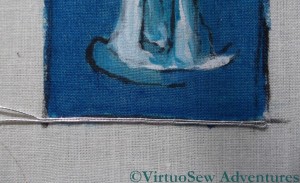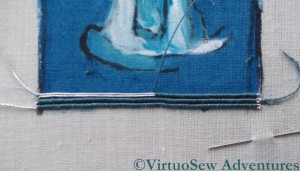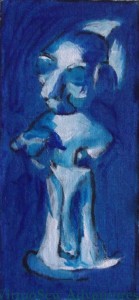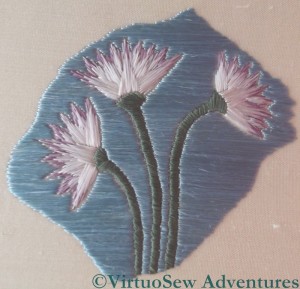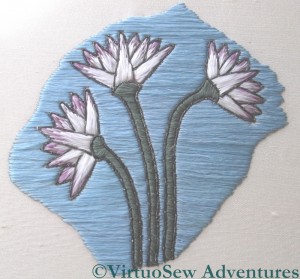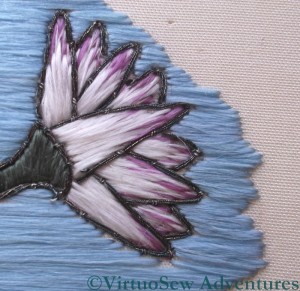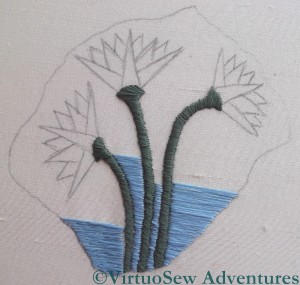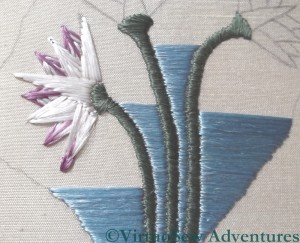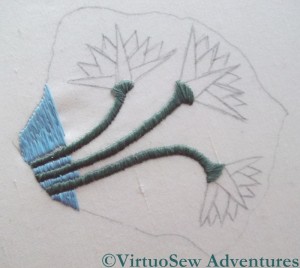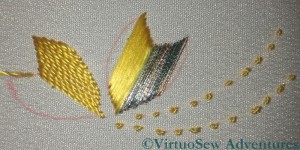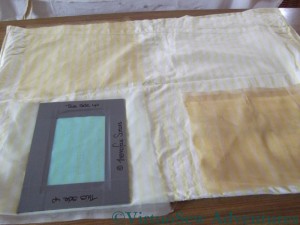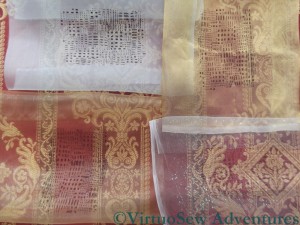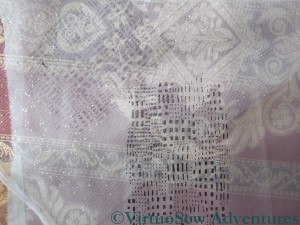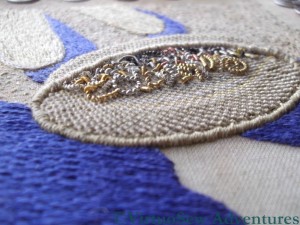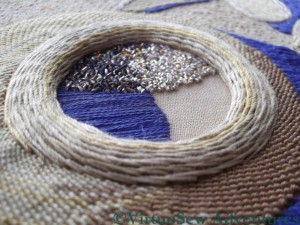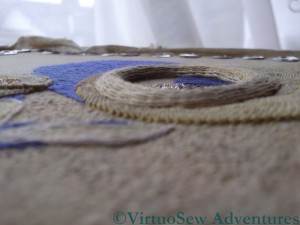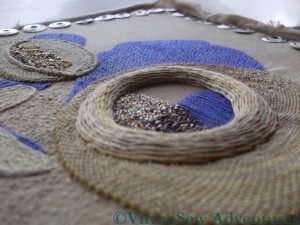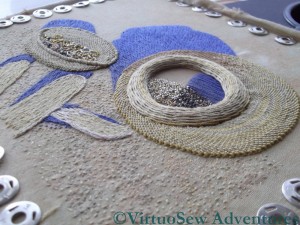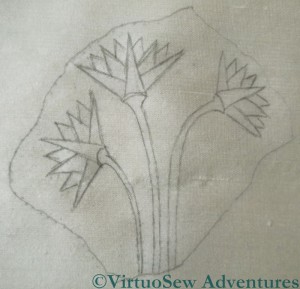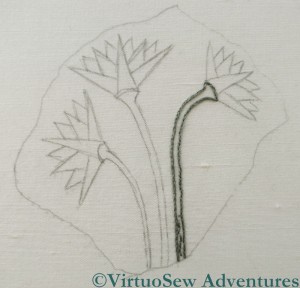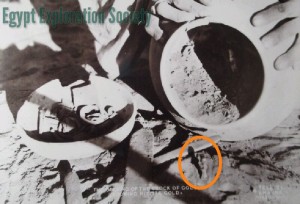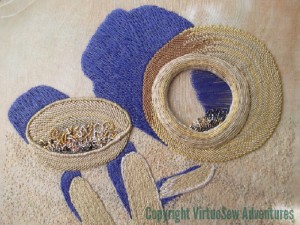Tag: Dreams of Amarna
The Hittite Amulet – Beginning to stitch
So, with the Hittite Amulet painted on my fabric, stretched, and ready to go, I have now settled down to stitch. I have decided to aim for a more strongly corded effect in the background of this piece than I used for Christus Natus Est, so each row of stitches will be worked over two rows of silver.
This in turn means that I will spend a lot of time wrangling the springy silver thread to make it lie close and straight. Even the first row was a challenge, and as I reach the core of the spool and find the thread that has been wound closely around it, I am expecting the challenge to become even more challenging!
Still, nothing easy was ever worth doing – so they say…
This second photo shows the stitching halfway along the third row of background at the base of the piece. You can see the ribbed effect is already building up, and it will create a good strong background. If I get the rest of it right, the Amulet should almost pop out of the surface at me!
I am still trying to decide how to organise my stitching of the Amulet himself, but I plan to allow the silver to show through across the entire design, spacing my silk stitches accordingly. The stitches for the design may cover two silver threads or only one, and I am going to try to space them using the original black and white photo for guidance, to create some sense of the shadows breaking up across the surface.
The Hittite Amulet – all by himself
Since I finished the Lotus Flower Tile Fragment, I haven’t had a piece for the Dreams of Amarna to work on. I’ve been thinking about several, of course, but in combination with the Online University projects I’m working on and my sudden idea for the Vision Of Placidus, none of them really caught fire.
Then I filled very dull, dreary afternoon – pouring with rain, with no light to embroider by (remind me, it’s summer here in the northern hemisphere, right?) – with the preparations for working the solo version of the Hittite Amulet. He’s going to be worked in or nué – actually argent nué, since I’ll be using a silver thread! – so the first thing to do was prepare the base fabric.
There were two photos from the EES to choose from, one of them rather moody, with the amulet seeming to look out from the black background, and the other, arguably better lit, and full face rather than three-quarter. Guess which I chose?
Yes, of course, the moody, dramatic one!
It’s very hard to trace a picture that doesn’t show everything you know is there. You will see that the lines I’ve traced produce a sketchy effect, not complete detail. That’s because I decided to paint more of the details onto the background fabric to help guide my needle, and the lines were really only there to guide my brush!
It may seem that creating this painted panel is a lot of work that will be completely hidden, but while my other or nué panel, Christus Natus Est, had simple sweeping lines, and the coloured background was merely there to prevent cream calico from grinning through any gaps, the Hittite Amulet is a very much more intricate design. Creating my painted version putting darks and lights in the right places took immense concentration and I would hate to have to concentrate that hard on the design when the execution is going to be so challenging.
Wish me luck!
The Lotus Flowers Finished
The laid silk satin stitches grew surprisingly quickly, in the end. I think of satin stitch as a very painstaking and tedious technique, but for some reason or other, I found the background of the Lotus Tile Fragment the reverse of tedious. I’m sure that the way flat silk spreads out helped with that, and likewise the increasing complication of working the satin stitches around the lotus flowers.
The horizontal stitches worked beautifully, creating the effect of a flowing stream behind the flowers. It can be hard to introduce enough movement into a design to prevent it seeming static, while at the same time avoiding any suggestion of hectic activity. In this case I think the balance between stillness and movement is reasonably well-achieved.
Once it was done to my satisfaction, I spent a bit of time searching online for images of other Egyptian representations of Lotus Flowers dating from the Amarna period. I was a little disturbed to find that many of the photos in the search results were from this blog, which made my search a little self-referential, but in the end I decided that I should put an outline in, since most of the Egyptian images were outlined.
I was influenced in this decision by the fact that I really enjoyed stitching this little piece, and I felt that re-stitching it if the outline did not please me would be no hardship at all!
I used a fine metallic thread, also purchased from Midori Matsushima, and couched it. For the stems I used three doubled threads and couched them – slightly twisting them – using a single doubled strand. For the flowers I used two doubled strands, couched with a single doubled strand. I’m not convinced that the different number of threads made a difference, but believe me, I won’t be unpicking it!
I’m pleased with it. The outlines do make it look a little more like some of the images I found in my search, and they will help the design to maintain its shape when it is overlaid with the gauze portrait.
Developing confidence in satin stitch
It may not seem as though much has been going on with the Lotus Fragment, apart from satin stitch, but I have in fact been learning a lot, and experimenting rather a lot too.
To begin with, I was intending to use a couching stitch for the blue background of the image. This is partly because I keep forgetting that the final Dreams of Amarna panels are not intended to be worn or leaned upon. The stitches would need to be quite long, which is contrary to my ingrained instinct to keep stitches short in order to make the finished article reasonably hard-wearing. But then, stitched on silk, using silk, it was never going to land in the washing machine!
After my short class with Midori Matsushima, I had a little more confidence in my satin stitch, and so I worked one side of the fragment in satin stitch and the other in Bokhara Couching, and then sat back and looked at them. Satin Stitch won, hands down. The flat silk spreads beautifully to help blend the stitches, and the reflectance of the silk filaments creates an almost radiant effect. So that small section of couching has been unpicked, and replaced in short order! In fact, the satin stitch fairly galloped away once I got settled and gained some facility with my mellor.
The lotus flowers themselves are giving me a little more trouble. As you can see in the second photograph, I have been trying various ways of stitching them. My challenge is that Mary Chubb describes the originals as “faintly lilac-tipped”, and so my experiments have two goals, not just one: I want to find the most effective way to use the silk to represent the lotus flowers, but at the same time it has to be a way that lets me tip the petals in the lilac without creating a clumsy effect.
The earlier petals use stitches that come to a point at the tips of the petals, crossing under a central stitch that seeks to smooth those tips. I am not happy with this – it looks clumsy and heavy, even though it makes adding in the lilac stitches fairly easy.
The later stitches use a more classical satin stitch, with the longest stitch on one long side of the petal, and shortening stitches creating the other side. This is better, and I think will be improved if I take all of the experiments out and then begin again, with the long stitch on the central axis of the petal and shorter ones to the side.
However, the challenge of creating the effect of the lilac tips remains. I want to blend the lilac and white stitches into one another, and for the life of me I can’t see how to achieve it, or even whether to stitch the lilac first or the white!
Progress on the Lotus Fragment
I have chosen to work the Lotus Tile Fragment using Japanese Flat Silk, which I bought at last year’s Knitting and Stitching Show in Harrogate, from Midori Matsushima. This is rather an adventure, because I have never used flat silk before, except when I experimented with one of Stef Francis’s overdyed flat silks.
Suddenly, therefore, it rather matters to me whether I produce the effect I’m looking for, which was not the case with the Experimental Seahorse, entertaining and instructive though he was to do!
Last week , Susan of Plays with Needles quoted a Buddhist proverb in her blog – “When the student is ready, the teacher will appear“, and it turned out to be true for me too. Entirely by accident, I discovered that Midori would be teaching an introductory workshop in Japanese Embroidery techniques, not fifteen minutes’ drive away…
In two hours, there was only time for the merest scuttle through the techniques – making a twisted thread (we made a four-into-one), learning how to work a Japanese knot, how to stitch with the twisted thread and with the flat, untwisted silk, and finally how to use one of the fine metallic threads. As it happens, the techniques I have ended up using for the Lotus Tile Fragment are (understandably given my background) more Western than Japanese, but although I am intending to use flat silk throughout, it has already occurred to me that I might work an interesting alternate version using Japanese embroidery techniques. I just need Midori to come back and run another short workshop in s0me of the slightly less basic techniques…
An Experiment in Screen Printing
My current plan for the Dreams of Amarna panels is to overlay the embroidered panels with gauze panels screen printed with the heads of Akhenaten and Nefertiti, and since the panels would be hard to store safely and out of the way while I do the embroidery I have always intended to do the screen printing last of all.
Then, as I mentioned when I was beginning on the Lotus Fragment, I had a Dreadful Thought. What if the gauze killed all the colour in the embroidery? Would it be possible simply to brighten the colours of the embroidery (which would also involve abandoning nearly everything I have done so far) or would I be able to find a suitable fabric? Obviously some early experimentation would be required… Fortunately, “Creative Stitches and Hobbycrafts” happened shortly after my Thought!
I found the stand for Thermofax Screens, and explained what I wanted to do. When I explained that the image I intended to print (in the end) would be of the style of an old-style newspaper print, the lady’s face cleared. Yes, she said, it would certainly be possible to print onto gauze, and when I eventually get to the appropriate stage, it would be possible for them to prepare screens for me based on images I provided. She also said that I should experiment with fabrics, but that synthetic gauzes were likely to prove more transparent than natural fibres. So I bought a starter kit and a screen that had some of the characteristics I expect my final images to have, and got ready to experiment.
The photo shows, from top left, clockwise: Silk organza, Silk Tissue, Synthetic Diamond Mesh Net, and a Synthetic gauze.
I’ve overlaid them over a strongly patterned upholstery fabric, and it’s clear that the bottom two are going to be better bets. The silk organza all but obliterates the upholstery material, so embroidery is going to stand no chance, and the silk tissue is only slightly more transparent.
This photo shows the contrast between the heaviest and lightest of the fabrics I have tested. The silk organza took up most of the ink that passed though the screen, and the design shows up clearly, but it reduces the fabric underneath it almost to a pattern of light and dark, with very little colour. By contrast, the diamond net has to be laid over the organza before the print shows up at all, as you will see if you look at the middle picture at full size.
To be absolutely certain, I will need to set up some of the embroidery as I intend to display it, and then hang the gauzes about an inch in front, but as an early indication, I think this gives me enough to go on that I can feel reassured. There are suitable fabrics for my purposes, and basic single colour printing is no harder than I remember from university.
I can set my worries aside and continue embroidering – just so long as I bear my ultimate plans in mind!
Close ups on The Crock of Gold Hoard
Very few words with this post – Megan asked for some pictures that showed the dimensionality of the various stitches, so here they are!
I’ve left the pictures larger than usual, so do click on them to have a closer look at the stitches and the purls!
I’ve enjoyed revisiting the Crock and looking at it from new angles. I would have loved a strong side light to pick up the glints, but is has been overcast – a good light for working on the Glittering Nightcap, which I’ve finally got back to, in spite of my breath condensing on the magnifier!
Beginning work on the Lotus Fragment
When I first wrote about the Lotus motif, in September (The Fragment of Tile That Started It All) it was because I wanted to buy materials for it at the Knitting and Stitching Show in Harrogate in November, which I duly did. And now that the Crock of Gold is finished, I can move on to the Lotus Tile Fragment! The colours I bought were soft and slightly greyish, rather than bright and clear, partly because that was all I could find, and partly because I was thinking more of the way Mary Chubb would have first seen the fragment, covered in dust.
However, just when I had got the design drawn out, I had a Dreadful Thought.
My intention for the final mounting of the two panels is to print a head of Akhenaten on a piece of gauze and stretch it in front of one of the completed panels, and a head of Nefertiti for the other. Just how fine and gauzy can it be and still create the effect I want of the Heretic Pharaoh and his Queen, brooding over the excavation of their city? How fine and gauzy a fabric can I find that will take a print? And how much brighter do the colours have to be to ensure that the jewel-like panels around the central panels shine like jewels, rather than being killed off by the gauze?
I shall finish this version, since I’ve started it, and I might, perhaps, need to begin learning about screenprinting, and experimenting with fabrics much sooner than I thought. If all the pieces I’ve worked so far need to be re-done in brighter colours, my current estimate will need to be revised outwards…
The Crock of Gold Hoard – Finished
Here is a close up of the finished chipwork on the Crock of Gold Hoard. I’m very pleased with how it has turned out. Especially with a strong side light, there is the right mixture of glint and dullness to suggest old, tarnished metal. I’ve used a mixture of rough purl (both tarnished and untarnished), and check purl, in several shades of silver and gold.
I decided not to use any of the pearl purl, which I used to create the effect of bangles and broken jewellery in the lid. I’ve taken care not to over crowd the chips, because if they started to pile up, it would reduce the illusion of recession that I’m trying to create.
You may recall that last time I posted I had only just spotted the Amulet, set in front of the Crock for the photograph, and I was wondering whether or not to include it in this particular piece. I’m intending to work an or nué version of the Amulet, so even if I fail to include it here, it will still figure in the completed panels.
I could simply tell you what I decided, without explanation, but I think that would be unfair.
This first photo shows the piece as I originally intended to finish it. There are the sticks in the foreground, the deep blue shadows of the Egyptian sun, the Crock, its Lid, and the chipwork and curls of the fragments of metal.
I think it looks pretty good, and in fact I’ve decided to leave it like this, without adding the Amulet.
The second photo shows my experiment with adding the Amulet. Since creating the Amulet in stitchery would risk causing damage to the fabric, damage which would be impossible to repair if I dislike the effect, I thought that using silver kid leather would be ideal.
I cut out the Amulet shape – approximately – and laid it on the piece, shifting it around and looking at it in different lights. In some lights, the silver kid drew the eye to such an extent that the rest of the piece might just as well not have been there. In others, it looked like a greyish smudge, killing all the other colours, losing the sunshine and shadow. What it didn’t do, in any light, was create the sense of dialogue between the Amulet and the Crock it had been guarding so faithfully for so many centuries that I was looking for.
I’ve kept the piece of leather I cut out, and may, later, add the padding and stitching to give it form, and keep it to sneak onto the finished work as a challenge for the viewer – Find The Hittite Amulet!
Crock of Gold Hoard – A Surprise in the Photo
I’ve been working on the Crock of Gold Hoard for months, now, with the photo or even an enlargement of it, close at hand at all times. My mother and I even spent several hours staring fixedly at the photo while we tried to sort out the shadows.
During all that time, something has been nagging me. Mary Chubb mentions that in one of the photos they took at the time of the discovery, the Hittite Amulet was placed in front of the Crock, rather as it had been on top of the Hoard for all those centuries before. And in all that time, with all that staring, I never found it.
And now I have – circled in orange here. In fact, now I’ve found it, I can’t not see it, but since it took me so long to spot it, I thought a bit of help might be in order for my readers!
And here’s the update on progress. I’m working slowly, a bit at a time, on the chipwork inside the Crock. The tarnished silver purl is creating just exactly the effect I thought it would, because the tarnishing hasn’t been even, allowing just the occasional glint to show through.
What I’m still not sure of is just how far I need to go to get the effect of the Hoard still within the Crock, which is a matter of some concern to me, because I don’t have an unlimited supply of tarnished purl.
Oh, and there is the other question – do I even attempt to represent the Hittite Amulet at this scale? I’m going to work it in or nue, as a separate piece, and as the embroidery is only about the size of a postcard, the Amulet would only be about a centimetre high, and if it goes wrong and needs unpicking it will probably leave a blemish.
Tricky.

